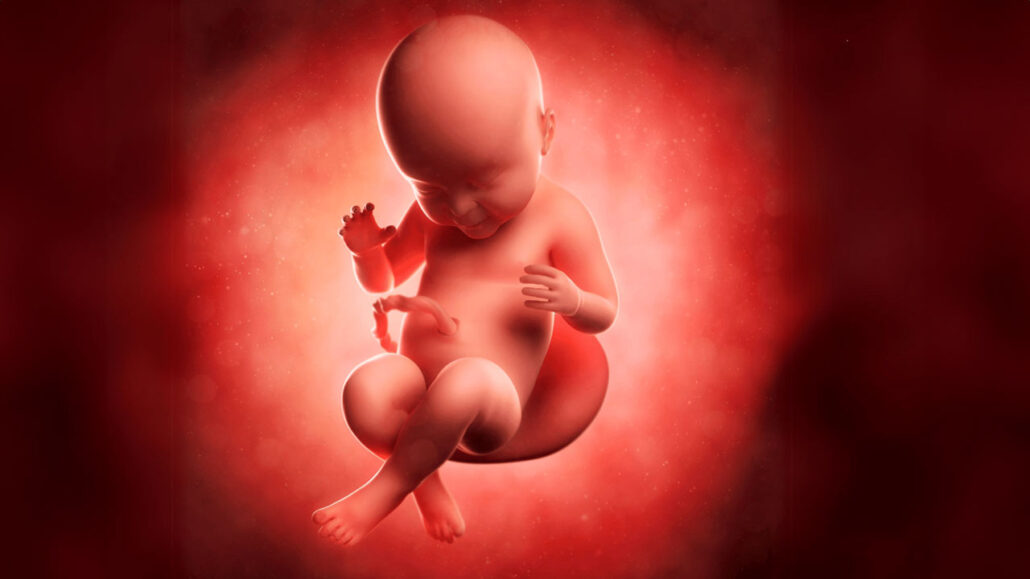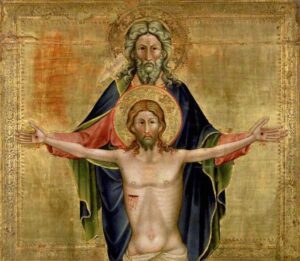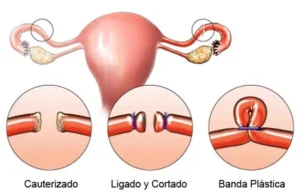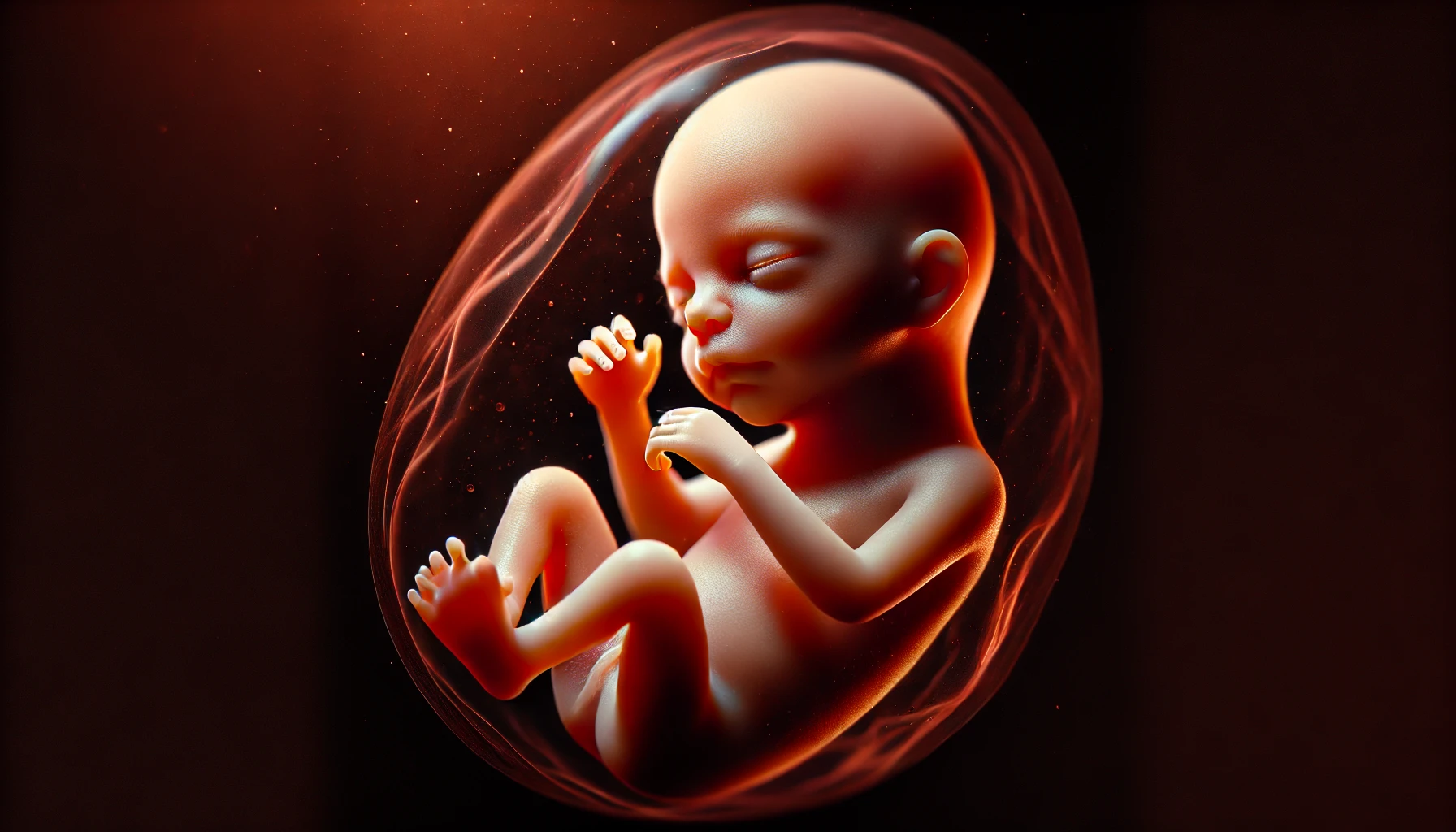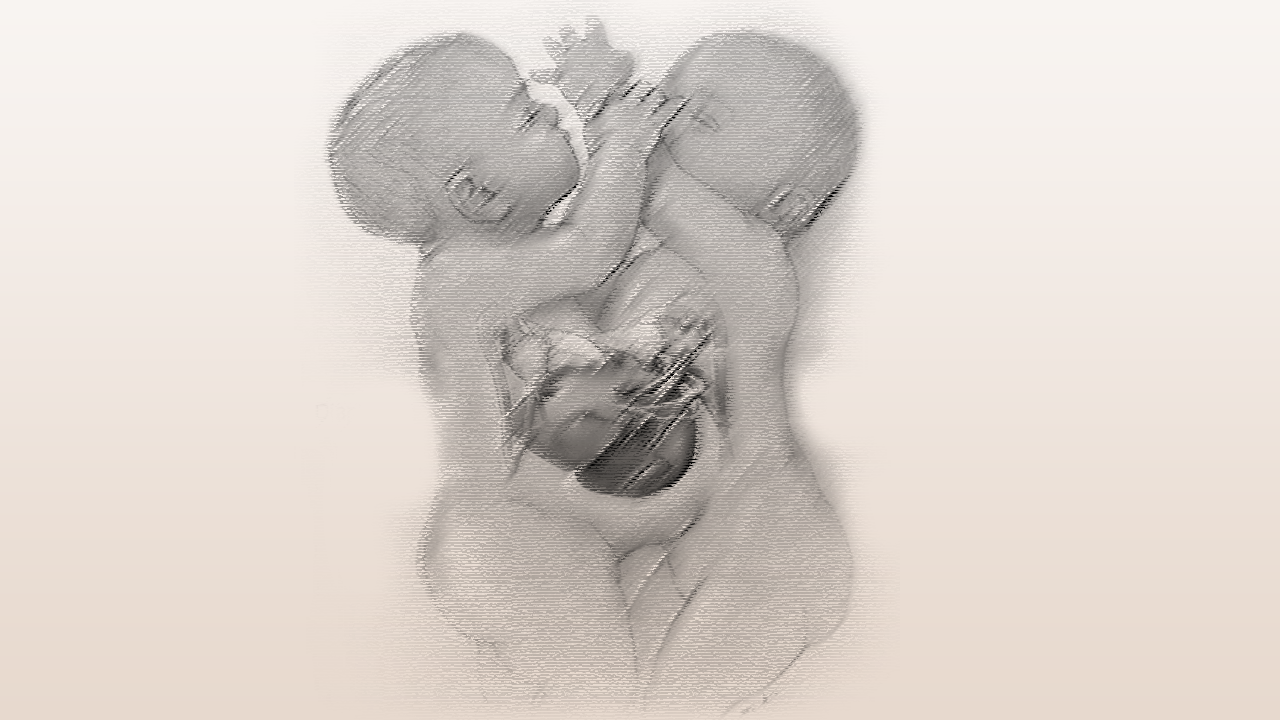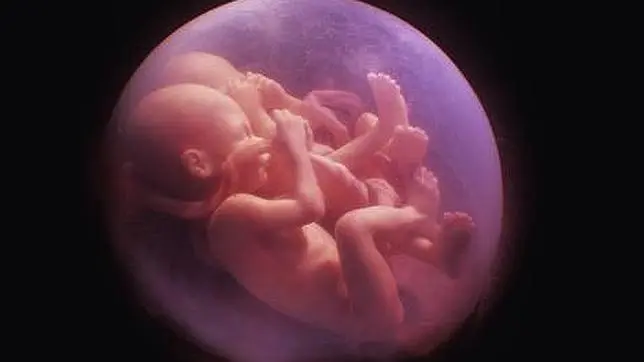Question:
When does a human being begin to be a human being?
Answer:
(The following is an excerpt from Fr. Fuentes’ Stolen Truths).
If you study medicine, biology, embryology, pharmacy, nursing, or some related sciences, it would not be strange for you to hear the most absurd things about the moment a human being begins to be a human being. Maybe you will hear it said that this occurs only two weeks after conception, or maybe in the moment of implantation (and only if this takes place), or even later. From these theories some logical conclusions can be drawn: before this moment “determined” by science there is no human being; and therefore, no harm is done to a human being in investigating and harming “this,” the fruit of conception, nor is it murder if it is destroyed, nor is there any sinister action if it is used as a deposit of cells, etc. Be careful, they are preparing you to hand yourself over to the macabre game of destroying your fellow creatures and taking the title of human being away from them before you do it. Not only are they stealing from you this truth that has been part of your life (you were also an embryo and you are reading this because from the very first moment you were treated as a human being), but they ask your complacency in the face of the daily massacre that our modern world carries out, or they invite you to consort with the modern slaughterhouses.
This chapter has such importance that I will try to deal with it in the clearest manner possible, although you will have to make an effort to read many technical terms that are necessary to make this truth clear. However, in spite of the complexity of language, you will see that this truth is not so difficult to assimilate.
THE BIOLOGICAL NATURE OF AN EMBRYO
In the first place I would like to give an account of the commentary by two Italian authors, A. L. Vescovi, and L. Spinardi, members of the “National Stem Cell Consortium” of Italy, who invite us to follow—with the facts from current science—the different moments of a human embryo’s development in order for us to draw our own conclusions about the moment it begins to be human. At the root of the debate about “artificial” fertilization, use of stem cells, cloning, etc., these two authors establish the biological basis to also offer a biological response to the debate about the beginning of life. The key question that should precede all discussion of the subject is this: When—if it is possible to determine—does human life properly begin? They respond that biologically and logically it can be established with certainty, but before looking at their reply, we follow their exposition. We will restrict ourselves only to the embryonic process (that is until two months old, when the term “embryo” is replaced with “fetus”) this will be enough for our purposes. Some authors use the term “embryo” to refer to the thing that develops in the womb of a woman “after implantation in the womb.” For ideological reasons, they use other terms, like “pre-embryo,” zygote or other similar terms for the events prior to implantation. This is an abuse of language that comes with bad intentions. It is enough for our objective, that by simplifying the language we will allow ourselves to use “embryo” for the process that goes from the moment of conception to two months.
For those who find some of the next pages dry, I remind you of the importance of being aware of the steps that describe embryonic development (a strictly scientific question), in order to have a true and correct basis for the moment in which philosophical (and also theological) questions are argued. Man cannot be cured if one does not know what a man is, or, in the words of Gustave Thibon, the medical technician cannot know what a sick person has if he does not know what a sick person is. It was not for nothing that they attributed to Galileo (c. 130 BC) the expression: “the best doctor is also a philosopher.”
a) The embryo and its origin
The development of a human being begins with an encounter during which a single sperm cell (male cell) unites with an egg cell, ovum (female cell), after a sexual act carried out during a woman’s fertile period. This is called fertilization. Fertilization includes a series of successive events: from the penetration of the sperm into the ovum, to the fusion of the cell membranes (what some call syngamy), to the union of the pronuclei of the two cells (each one of which has 23 chromosomes) in order to create a new cell with a complete genome (called diploid) of 46 chromosomes. We remember that our body’s cells are divided into two main groups. All types of cells (nervous, muscular, epithelial, and skeletal cells) except one have 46 chromosomes, that is to say, the complete patrimony with our genetic information (for this reason they are called diploids). The only one that does not share these characteristics is the sexual cell or germ cell (thus called because it is destined to be the seed of a new being; it is the sperm in the man, and the ovum in the woman) that has only half of this genome (23 chromosomes; male germs can contain either X or Y chromosomes because the diploid male is XY: an ovum contains X because the female diploid is XX) because they are destined to unite, forming one new being with a complete genome, half contributed by the father and half by the mother.
The ovum fertilized by the sperm is a new cellular entity called the zygote. This zygote will begin to divide itself, first into two cells, then in four, etc. The two cells that came from the first cell division appear to possess different characteristics that then persist in successive cell divisions. Therefore, the embryo comes from the progeny of one of the cells and the embryonic membranes (among which is the placenta) come from the progeny of the other.
However, it’s not worth talking about the cell’s “destination,” because, if one of the first cells is removed, those remaining are in a condition to compensate for its absence.
After fertilization, the first cell divisions of the zygote occur slowly in a process called segmentation that, beginning from one cell, carries out the formation of two, four, eight, and sixteen cells. The cells formed in this way are called blastomeres and the organism as a whole is called morula (named such because of its resemblance to a mulberry). Many zygotes do not get past this stage of development and die by spontaneous abortion (therefore, before arriving at implantation). When the morula reaches the uterus it is made up of 32 cells and begins to swell, absorbing liquids between the blastomeres. The spaces that contain the liquids come together causing a cavity. When this cavity can be detected, the whole organism is called the blastocyst. The outer most cells of the blastocyst, above all those that surround the cavity, assume a flat form, and give rise to the cells of the trophoblast. These cells will contribute to the formation of the embryonic membranes. The internal cells of the blastocyst give rise to the cells of the inner mass: these make up the formation of the new organism. The inner mass cells can give rise to all types of cells present in the adult individual. This is why they are called pluripotent—it is not correct, however, to call them, as some do, totipotent, because they are not capable of giving rise to the cells that make up the embryonic membranes (that come exclusively from trophoblasts). These embryonic stem cells (mother cells) are separated, precisely, from the cells of the inner mass cells.
In the uterus, the blastocyst grows and adheres to the endometrium (this is the name for the inner wall of the uterus) by means of the trophoblasts. This act is called implantation of the blastocyst and occurs six days after fertilization. The embryo begins the second week of development. The implantation of the blastocyst is completed in three or four days and is generally finished before day twelve. During implantation, the trophoblast cells actively make contact with the surface of the endometrium and totally penetrate the epithelium. At the point of contact with the uterine mucous, it develops a primitive circulatory system that provides nutrition to the implanted blastocyst and to the embryonic membranes that it is forming. The blastocyst’s cavity tends to expand and give definitive separation between the inner mass cells and the trophoblasts. In this way it forms the first embryonic membrane called the amniotic cavity. From the trophoblast, another embryonic membrane is generated called the chorion (the membrane that enfolds the embryo and keeps it apart from the uterine wall) from which the chorionic villus are successively derived, and finally the placenta. The blastocyst is thus completely nestled in the rich endometrium or uterine wall and irrigated by the maternal blood. When the fetal circulation system is developed, the fetal and the maternal blood remain separate and nutritive, carrying oxygen and waste products in the proper direction through the barrier of the placenta.
b) From implantation to gastrulation
During the phases of implantation in the uterus, the trophoblasts differentiate themselves in a way that anticipates the cells of the inner cell mass, in order to guarantee the nutrition of the embryo. However, the cells of the inner cell mass also undergo a series of changes. First of all they divide in order to generate 2 layers: the outer epiblast (or primitive ectoderm) and the more inner hypoblast (or primitive endoderm). The supportive embryonic membranes are external to the embryo that begins to develop independently, although they remain in close continuity with them.
At the beginning of the third week of development, the epiblast cells thicken and give rise to a structure called primitive streak that extends from the principal extremity to the system of the embryonic disc, thus defining the anteoposterior axis and the bilateral symmetry of the embryo. Some epiblast cells emigrate and will end up giving rise to the three layers called ectoderm, mesoderm, and endoderm. This whole process is called gastrulation. It must be noted that all the tissues of the future organism are derived from epiblast. As of today, it appears that the hypoblast does not contribute to the formation of any embryonic structures; it seems that it would have a transitory function to protect the epiblast.
Gastrulation is a crucial point in the embryo’s development; during this process an essentially spherical blastocyst transforms into a cylindrical structure with head, tail, and three distinct embryonic walls or layers. The ectoderm gives rise to the skin, the nervous system, and the sensory structures of the eyes, nose, and mouth. The mesoderm gives rise to the skeletal, muscular, and circulatory systems. The endoderm gives rise to the epithelium lining of a number of systems including the digestive tract and the respiratory system.
c) From the formation of the central nervous system to genesis of organs
The term neurulation indicates a series of processes leading to the formation of the central nervous system in the embryo. From the cranial extremity (rostrum) of the primitive line, a large structure that extends further in the rostral direction develops in the mesoderm. This structure is called notochord and constitutes the anteoposterior axis of the embryo. Over the sides of the notochord the vertebral column will develop. In this stage of development, the neural plate is brought about when the notochord and the adjacent tissues exert induction upon the ectoderm. The edges of the neural plate are elevated to form the neural folds. The nueral folds unite themselves, forming the neural tube, starting from the center and moving toward the two extremities with a mechanism similar to a zipper. This process is completed by the third week of embryonic development. The mesoderm, that confines the neural tube, is differentiated by a series of structures called somites. The first pair of somites appears in the cranial part of the neural tube by the twentieth day after conception. The other somites are formed little by little in the tail end until day thirty. The mesenquimal stem cells, cells that arise from the somites, give origin to the major part of the skeletal structure and the muscular system.
The formation of the fetal circulatory system begins in the embryo three weeks after conception, even though fetal blood is not produced till the fifth week. The heart looks like a big cup of blood that folds on itself to produce the atrio and ventricles that will become its final form. Nevertheless, in its first structure with its tube form, the plasmatic membranes of some of its cells possess an electric potential and a contractible capability to make the heart start beating by the third week, forming a primitive circulatory system.
The principal structures of the organism and the connections between the various organs and systems are formed between the fourth and eighth weeks of embryonic development. First the embryo folds itself many times, transforming the linear and flat structure of the neural tube and the somites into a “C” shaped structure. This structural change gives the cerebrum, the intestines and other organs a more suitable position for the formation of anatomical connections. During the fourth week the extremities of the neural tube close, delimiting what would become the central nervous system and also throughout this time the first cartilage of the limbs appears. During the closing of the neural tube, the primordial structures of the cerebrum begin to develop. In this stage, the cranial nerves, like those of the eyes and the muscles of the face, also begin to develop. The embryonic cerebrum starts to develop in the fifth week, along with the appearance of the optic vesicle and the retina of the eye. Development continues as various organs emerge: the skeletal structure, the limbs and the face. All this happens following the eighth week after conception, when the embryo is already called a fetus. Once the basic elements of the process have been established, during the development of the embryo, the full development of the main body and the infinite connections among all the bodily structures develop during the fetal stage and continue even after birth.
SOME CONSIDERATIONS
Keeping in mind what we have just explained following Vescovi and Spinardi (which is similar to what can be found in the human embryology chapter of any medical or biology book) we can draw some conclusions of enormous importance.
a) The nature of the embryo
The first question the authors themselves rightly raised: “The principal problem of the debate about the nature of the embryo centers on one fundamental point: Where is it licit, from a strictly biological point of view, to draw the line between life and ‘non- life’?” Or, can we determine a moment in this process when we can say that before there was no human life and afterwards there is? “The answer,” they continue, “is in reality dramatically simple. And it is this, the beginning of life coincides with the act of forming a biological entity that contains and is gifted with the entire program of growth and with the information necessary to unfold and progress through all the stages of development that characterize a human being and that are an integral part of his natural history—zygote, morula, blastocyst, embryo, fetus, neonate, child, adolescent, man—until death. This end coincides with the loss and/or destruction of such information and/or capacity. Based on this, it is evident that the beginning of life in a human being coincides with the act of fusion between the sperm and the ovum, which brings about the creation of a zygote and the chain of events that culminates in the birth of a newborn baby.”
These authors also propose making the analysis from the other perspective: starting from the adult individual. We try to travel backwards in his biological history, looking for a “break in continuity,” (that is to say, an interruption) in its vital process. “We immediately note that such a break of continuity occurs only in the act of fertilization.”In all other stages of development life is present (and this refers to autonomous life, advanced, and directed from the embryo itself). This allows us to see that “the different stages commonly suggested as the boundaries between life and non-life— implantation in the uterus, development of the brain, self- consciousness—appear arbitrary. These stages merely represent the boundaries between different phases of vital development, but are all contained within this development, and do not represent the boundary of vital development itself.”
Therefore they conclude by saying that all of the attempts to reduce the embryo to an entity devoid of life are not viable and incorrect biologically and logically.
Thus, holding—as some authors have claimed—for example, that the embryo is not a living being because it is incapable of “communicating” (connecting with others) is absurd because the embryo communicates with his mother from the first stages of development. He does this through the exchange of very specific chemical molecules. The discrimination between life and non-life, therefore, is not based on the inability to communicate but on the form of communication used: chemical for the embryo, mechanical (sound, the vibration of air) in the adult. For those who deny the embryo the title of human their problem with it is that it communicates with his mother without using the voice or gestures of the face and hands.
We find the same fallacy in those who deny the embryo the category of human being because he would be incapable of elaborating information or of acting in a self-conscious way. If this were the case, we could come to categorize as non-living a significant number of those affected by important pathologies, for example, those suffering from Alzheimer’s, a disease that can totally disable the cognitive faculties.
b) The moment of passive conception
In speaking of the human soul we have said that a human being is such because he has a spiritual soul. If we say that the embryo is a human being, we have to affirm at the same time that he has a soul; that which does not have a spiritual soul is not human. Now, from what moment is the embryo a human person, that is to say, has a human (or spiritual) soul?
We are not going to return to considering the answers that many thinkers give with respect to the human being; it is enough that we just keep them in mind. Some hold that man is the result of chance or accident (that is to say, from the unplanned convergence of factors that produced not a piece of marble or a grain of wheat, but a man). Those that respond in this way, sooner or later conclude that man is absurd (Sartre dared to say clearly that for him, “man is a useless passion”, “condemned to be free […] thrown into the world”, and destined for nothing). But it is not possible to (seriously) think this way, and even less to work out the consequence of this claim. In effect, that which is born by chance lives by chance and is utterly given to chance, without law or any end, and no man can live with this perspective. With respect to this Basso writes: “More concretely, it is fitting to ask: Could it be that life, with its distinctive perfections (the complexity of its mechanisms, its remote preparations and its proximate arrangements) is a simple product of chance? If one has made, be it only once, the approximate calculation of the mathematically infinite number of fortuitous coincidences necessary to bring together a miniscule cell of four microns by two (the sperm) twenty three chromosomes with their 50,000 perfectly programmed genes, he will come down on the affirmative side of the aforementioned question. Believing in chance to such an extreme could even be called faith!”
Others have claimed that the human being in an embryonic state is potentially human “biological matter” and that it only acquires the title of person through his free recognition and free acceptance on the part of the adult society. For example, René Frydman claimed that embryos do not possess the attributes of a human person, but only their potential. In order to acquire these attributes, the embryo must be desired by an adult and must surmount the concrete difficulties of development. In this manner, the person would be a social construct, the artificial product of selective and arbitrary social adoption. From this reasoning they will logically conclude that one can then renounce his personhood by desiring to not live. Therefore, taking away life from someone who no longer wants to relate with others or from those who are set apart from his society . . . would not be murder (now we have made euthanasia legitimate!).
We have already said that man begins to be a person, a human being, upon receiving from God the spiritual soul that takes the function of form in the complex human being. The Catholic Doctrine affirms this, saying: “‘God created man in his own image, in the image of God he created him, male and female he created them’ (Gen 1:27). Man occupies a unique place in creation: (I) he is ‘in the image of God’; (II) in his own nature he unites the spiritual and material worlds; (III) he is created ‘male and female’; and (IV) God established him in his friendship. Of all visible creatures only man is ‘able to know and love his creator.’ He is ‘the only creature on earth that God has willed for its own sake,’ and he alone is called to share, by knowledge and love, in God’s own life. It was for this end that he was created, and this is the fundamental reason for his dignity; St. Catherine of Siena asked God: What made you establish man in so great a dignity? Certainly the incalculable love by which you have looked on your creature in yourself! You are taken with love for her; for by love indeed you created her, by love you have given her a being capable of tasting your eternal Good. Being in the image of God the human individual possesses the dignity of a person, who is not just something, but someone. He is capable of self-knowledge, of self-possession and of freely giving himself and entering into communion with other persons. And he is called by grace to a covenant with his Creator, to offer him a response of faith and love that no other creature can give in his stead.”
We have already dealt with this theme in the chapter about the soul; what we bring up now is precisely something that the previous chapter left hanging: When does the soul begin to be present in this being, which begins to have life at conception and will end with his natural death (maybe upon reaching an old age)?
It is clear that those who say that man is the result of chance will say that he began to be a person when so produced by happenstance, and therefore this will depend on chance in every case. Those that hold the relational theory will say that it is when society accepts the new individual (therefore, an embryo not accepted as a person or an “unwanted” pregnancy makes this “thing” something other than a human person). But those who hold that everything began with God’s creative intervention of the soul (passive conception) will have to conclude that the new being begins to be a person when God infuses the human soul into the organism capable to receive it.
Accepting that the soul is created and infused by God, we encounter a curious fact of historical interest: the theory of delayed hominization. This theory was defended in antiquity not only by pagan philosophers like Aristotle (with his theory known as epigenisis, a term coined in 1651 by William Harvey and not used by Aristotle himself) but also a few centuries later by the great Christian thinkers, both men of science and theologians, including those along the lines of St. Albert the Great and St. Thomas Aquinas. Aristotle’s theory is that the formation of living organisms is achieved through a slow process in which they gradually acquire their definitive form, progressively replacing imperfect forms with other more perfect ones until the definitive form is reached. Aristotle held and defended this against Democritus who had defended the theory of implicit pre- formation, precursor to all the preformationist theories (the preformationists held—I don’t know if anyone would argue this today—that the organs of the whole organism were already pre- formed in the ovum or sperm; we would have—in the case of man—a type of microscopic perfect little man or homunculus as some called it which can been seen in the Goethe’s literary work, Faust). The danger that medieval scientists and theologians wanted to prevent in returning to Aristotelian delayed hominization was precisely this preformationism that some Augustinian theologians defended. Against this, St. Thomas—who, like all the thinkers, could not rely on any data other than what was offered by the science of his time—defended delayed hominization, saying that the “body is formed and progressively goes preparing itself in view of the soul,” receiving a series of “souls” (not spiritual but imperfect, and therefore, like those that non-human beings have) that go on replacing themselves, in such a way that “when it is imperfectly disposed, it receives an imperfect soul; and when it is perfectly disposed, it receives the perfect soul,” that is, the spiritual one. St. Thomas expounds this doctrine for the purpose of explaining the case of Christ; He was an exception given that his “body, on account of the infinite power of the agent, was perfectly disposed instantaneously. Wherefore, at once and in the first instant it received a perfect form, that is, the rational soul.” I want to emphasize two things in this theory.
- The first is that the supporters of delayed hominization condemned abortion as a crime, although they admitted that the embryo received the spiritual and immortal soul only in the last stages of its formation. There was some hesitation with respect to this by some theologians like Peter Lombard. Nevertheless, the same authors maintained that abortion of still inanimate embryos, although it was not homicide, was equally illicit. In any case, the doctrine of the Church and that of the majority of the theologians did not support this. I want to clarify that the debate about the subject did not center on the approval of abortion in these cases, but around decriminalization (that is, not imposing canonical penalties) in the case when a fetus was not yet human. It is interesting that the majority of ancient authors, whether accepting—as certain or possible—delayed hominization or not, they always adhered to the gravity of abortion in whatever stage of development. Those who have studied the implications of St. Thomas’s doctrine on this subject affirm that he, although supporting delayed hominization, did not accept abortion as licit in any phase for the principal reason that he held that “what nature intends, God intends through her.” Therefore, interrupting the biological process of a human being tries to prevent the appearance of a human life desired by God, and thus will be an attempt against a human life, be it direct (if the soul has already been infused) or indirect (if it had not yet been infused). In this, St. Thomas and the ancient moralists were guided by the principle, “probable life, certain life,” wishing to say that while there is the probability of personal, human life, it must be treated as if it existed with certainty, because the risk implies exposing oneself to consciously committing murder.
- This discussion is also valuable because it was elaborated with insufficient scientific information about the embryo. The solution of these scientists, philosophers, and theologians would have been different if they had possessed the data of current bio-genetics. Modern bio-genetics make us aware of how the members and definitive organs are not actually present in the sperm, nor in the ovum, nor in the embryo—as preformationism ignorantly proposed—but neither is it necessary to wait for a moment late in the evolution of the embryo to see the given conditions of matter—body—adequately disposed to receive the soul, since in the very moment of conception the totality of the genome is given. This complete genome perfectly contains all the capabilities that the embryo, the fetus, the child, and the future adult will develop with the passage of time, always beginning with the orders emanating from the embryo itself. St. Thomas accepted that God could prepare a body that was perfect from the first moment and in such a case it would receive the soul immediately (for him this was the case with Christ). I am sure that if St. Thomas had known what the embryo really was, its genome and capacity to self-direct the process of gestation, he would have considered such a state as the state of (relative) perfection necessary in order to judge the matter disposed for the soul and would not have had to distinguish the case of Christ from other men insofar as the moment of his passive conception.
I expressly point out that the past discussion about delayed hominization is very valuable—not as some erroneously think as an objection to the Catholic doctrine from its own theologians—but because it shows us that: (a) Supporting delayed hominization (like many modern scientists, although they do not speak of passive conception but of hominization or personalization) is an error linked to a lack of knowledge about the embryo’s biological nature. If the scientists, philosophers and theologians of the past fell into this error, it cannot happen in our time with the knowledge we have of genetics and embryology. (b) It shows us that in spite of what they believed about such delayed hominization, the moral attitude will always be one of absolute respect for the embryo.
Now, we should be conscious that since we cannot have direct, experimental knowledge of either the soul or the divine creative act, we cannot give a “direct” response to the question about the moment in which the infusion of the soul takes place. However, with what we have said above about the embryo’s biological development, we can attempt an “indirect” response. This indirect response is based on an absolutely objective truth that permits us to confirm with certainty the moment in which this new being is already given the conditions to be a human person. If such conditions are verified, then we should conclude that it is a human person (or at least have to conclude that the contrary cannot be said, that “it is not a human person”). This fact, reinforced today by genetic studies, is established: in the whole process (from the sexual act between a man and a woman, fertilization, its embryonic development, birth, growth, adulthood, old age, and death) there is only one objective truth that permits us to say: “biologically in this moment there is a new being.” That moment is the conception or fertilization that results in a new fully individualized being, different from the cells that give it origin and different from the maternal organism that nurtures it.
I want to demonstrate this by citing a few pages of a very valuable study by Professor Angelo Serra, a prestigious geneticist. It deals with the point in which this author, after having described the embryo’s biological development in a manner very similar to what we have done above, proceeds to what he calls “biological induction,” meaning, the process by which a scientist, starting from the experimental data that science gives, reaches proven conclusions. The text says: “So far we have very briefly described the first stages of human embryonic development, and hinted at its genomic control. We had not intended either to verify or to falsify any particular hypotheses. The aim was to offer a basic knowledge of the complex biological process of the development of a human being. This knowledge is the premise to an answer to the questions: ‘What is the status of an early human embryo’, and ‘When does a human being start its own life cycle’. In order to answer these questions, there is no need to make new hypotheses, but simply to approach our data inductively.”
He then continues to point out how no moment other than that of fertilization can be pinpointed as its beginning and the acquisition of the definitive title of human being (that is, when it starts to be a person, and from our point of view, the moment of the soul’s infusion, respectively). This is because from this moment three fundamental properties are found in this being that indicate that we have an autonomous and complete individual (in regards to individuation), although it has not developed all of its capabilities. Those three properties are coordination, continuity, and graduality. Serra continues, saying:
[a.] Coordination
“The first property is coordination. Embryonic development, from the moment of the fusion of the gametes up to the formation of the embryonic disc around 14 days from syngamy, and still more patently afterwards, is a process where there is an evidently coordinated sequence and interaction of molecular and cellular activities, under the control of the new genome, that is modulated by an uninterrupted cascade of signals which are transmitted from cell to cell, and from the external and/or internal environment to the single cells.
“Precisely this undeniable property implies and, even more, requires a rigorous unity of the being that is steadily developing. The more research advances, the more this unity appears guaranteed by the new genome, where a great number of regulator genes assure the exact time, the precise location, and the specificity of the morphogenetic events. J. Van Blerkom underscores this property in concluding an analysis of the nature of the developmental program of the first stages of mammalian embryos: ‘Available evidence suggests that developmental events in the maturing oocytes and early embryo follow a schedule directed by an intrinsic program. The apparent autonomy of such a program indicates interdependence and coordination at the molecular and cellular levels to result in the expression of a cascade of developmental events’.
“All this leads to the conclusion that the human embryo—like any other embryo—even in the earliest stages is not, as N. M. Ford states, ‘only a cluster of cells’, ‘each of which is a distinct ontological individual’, but that the whole embryo is a real individual—in the sense declared in the first section—where the single cells are strictly integrated in a process through which it autonomously translates, moment after moment, its own genetic space onto its own organismic space.
[b.] Continuity
“The second property is continuity. It seems undeniable, on the basis of the data presented above, that a new life cycle starts at syngamy. ‘The final function of the sperm cell is to fuse with the egg plasma membrane. At the moment of fusion [i.e. syngamy] it ceases to be a sperm and becomes part of a newly formed cell, the zygote’. The zygote is the primordium of the new organism, which is at the very beginning of its life cycle. If one considers the dynamic profile of this cycle in time, it clearly appears to proceed without interruptions: the first cycle does not end at the embryonic disc, nor does another cycle start from that point on. A single event, such as cell multiplication, or the appearance of the various tissues and organs, might appear discontinuous to our eyes; however, each one of them is the final expression at a given instant of an uninterrupted succession of, so to speak, infinitesimal events connected one to the other without a break in continuity
“This property implies and establishes the unicity or oneness of the new human being: from syngamy it is always the same identical human individual who is being autonomously built up according to a strictly defined plan, while passing through stages that are qualitatively ever more complex.
[c.] Graduality
“The third property is graduality. The final form is reached gradually: it is an ontogenetic law, a constant of the reproductive process. This law of the gradual building up of the final form through many steps, starting from the zygote, implies and claims a regulation that must be intrinsic to any given embryo and keeps the development permanently oriented in the direction of the final form. It is precisely because of this intrinsic epigenetic law, which is written in the genome and begins to operate from the fusion of the gametes, that any embryo—and, therefore, the human embryo as well—permanently maintains its own identity, individuality and unicity, being uninterruptedly the same identical individual during the whole process of development, from syngamy onwards, notwithstanding the ever increasing complexity of its totality.
“W. J. Gehring clearly recognized this law while foreseeing the future advances of developmental genetics: ‘Organisms develop according to a precise developmental program that specifies their body plan in great detail and also determines the sequence and timing of the developmental events. This developmental information is stored in the nucleotide sequences of the DNA […] The developmental program consists of a precise spatial and temporal pattern of expression of these structural genes that forms the basis of development. Normal development requires the coordinate expression of thousands of structural genes in concerted fashion. Since independent control of the individual structural genes would lead to a chaotic development, we might predict that there are controlling genes that regulate the activity of groups of structural genes coordinately’.”
And Serra concludes with “the answer” that these facts give us: “It is unmistakably clear that the above three properties, when truly dispassionately considered, perfectly meet the essential criteria established by the meta-biological reflexion for the definition of an ‘individual’.
“Thus, the logical induction from the data afforded by the experimental sciences leads to the unique possible conclusion, that apart from fortuitous disturbances, at the fusion of two gametes, a new real human individual initiates its own existence, or life cycle, during which—given all the necessary and sufficient conditions—it will autonomously realize all the potentialities with which he is intrinsically endowed.
“The embryo, therefore, from the time the gametes fuse, is a real human individual, not a potential human individual.
“We believe that the insightful statements of the Instruction on Respect for Human Life in its Origin and on the Dignity of Procreation, published by the Congregation for the Doctrine of the Faith in 1987, are scientifically correct. They read: ‘Recent findings of human biological science […] recognize that in the zygote resulting from fertilization the biological identity of a new human individual is already constituted’.” Here ends the study of Angelo Serra.
In any case, we insist that if someone does not accept this scientific truth as determining the moment of passive conception, that fact would not leave him authorized by any other data to choose another moment as the beginning of the human person, since all other moments (suggestions have been implantation, the end of two weeks, two months, etc.) would not present any essential change from the moment just prior and would then deal with an arbitrary determination. Moreover, it would be like saying, “Not being able to confirm experimentally at what moment the creating intervention of God occurs, I decide that it occurs at this moment.” For this reason, the term “pre-embryo,” coined to designate the time prior to these arbitrary determinations is as arbitrary and biased as the determinations themselves. On this point, the Declaration on abortion says: “From a moral point of view this is certain: even if a doubt existed concerning whether the fruit of conception is already a human person, it is objectively a grave sin to dare to risk murder. ‘The one who will be a man is already one’ (Tertullian).”
***
What we have embarked upon in this chapter has major importance for our lives, especially for the life of a scientist or a student in the careers related to life. From the principles we have set out, it can be understood that the following are illicit: some techniques of human reproduction (like in vitro fertilization), embryonic experimentation, cloning and above all abortion (in any of its surgical or chemical forms).
If these principles are denied, one can fall into accepting the most deviant experimental practices (techniques very similar to those that our society condemned in Nazism): eugenics (killing children born with disabilities or who simply do not meet the expectations of their parents), the creation of organ banks (banks of human beings stored in the embryonic state, destroyed for their cells and organs when such are needed by an adult) and all manners of abortion and infanticide.
Do not be surprised by this and do not be deceived by the titles or achievements that a scientist may have; those who deny the humanity of an embryo can come to defend the most criminal positions. To show this, just read the chilling declarations of Dr. James Watson, winner of the Nobel Prize for Medicine and Physiology (famous for his discovery of the structure of DNA together with Francis Crick): “Many malformations and series of defects are only seen after the creature is born, frequently because not all the unborn can be subject to pre-natal diagnostics. This is why I agree with my colleague and friend, Francis Crick, in favor of not declaring newborns ‘alive’ until three days after they come into the world, giving the parents, during this time, the possibility of preventing the incurable child a life full of suffering.” Yes, you have just read the vindication of infanticide by the two scientists who discovered the structure of DNA, one of the greatest achievements in biogenetics. If you are reading these pages, you must be grateful to your parents, for they did not lend their ears to these and other authors who propose the possibility of becoming modern Herods, and for yourself, not to be one more of the innumerable members of the legion of holy innocents.
For Further Reading
- Bedate, Carlos Alonso and Robert C. Cefalo. The Zygote: To Be or Not Be a Person. Journal of Medicine and Philosophy 14:6 (1989): 641-645.
- Serra, Angelo and Roberto Colombo. “Identity and Status of the Human Embryo: The Contribution of Biology.” In Identity and Statute of Human Embryo. Edited by Juan de Dios Vial Correa and Elio Sgreccia. Vatican City: Libreria Editrice Vaticana, 1998.
Available in Other Languages
- Ballesteros, Jesús. “El Estatuto del Embrión.” Fundación Interamericana Ciencia y Vida. www.ulia.org/ficv.
- Blázquez, Niceto and Luis Miguel Pastor. Bioética Fundamental. Madrid: Editorial Católica, 1996.
- Castilla, Blanca. “Comienzo de la Vida Humana: Aspectos Filosóficos.” Cuadernos de Bioética 8:31 (1997): 1113-1118.
- Colombo, Roberto. “Statuto biologico e statuto ontologico dellé embrione e del feto umano.” Anthropotes XI (1996): 132ff.
- De Santiago, Manuel. “Estatuto Biológico, Antropológico y Ético del Embrión Humano.” Bioetica. www.bioeticaweb.com/estatuto- biolasgico-antropolasgico-y-atico-del-embriasn-humano-dr-manuel-de-santiago (accessed January 11, 2015).
- López Moratalla, Natalia and María J. Iraburu Elizalde. Los Quince Primeros Días de Una Vida Humana. Pamplona: EUNSA, 2004.
- Melina, Livio. El Embrión Humano: Estatuto Biológico, Antropológico y Jurídico. Madrid: Rialp, 2000.
- Monge,Fernando.PersonaHumanayProcreaciónArtificia.Madrid: Palabra, 1998.
- Orrego Vicuña, Fernando. “Acerca de la Infusión del Alma Espiritual.” arvo.net (accessed 2005).
- Possenti, Vittorio. “¿Es el embrión persona? Sobre el estatuto ontológico del embrión.” In C. I. Massini and P. Serna, ed. El Derecho a la Vida. Pamplona: EUNSA, 1998.
- Sgreccia, Elio. Manuale di Bioetica. 2 vols. Milan: Vita e Pensiero, 1998.
Original Post: Here
Related Post: Is Contraception a Grave Sin?

